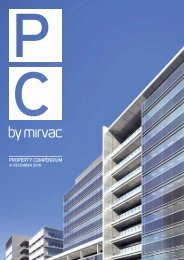MIRVAC gRoup AnnuAl RepoRt 2012 - Mirvac - Mirvac Group
MIRVAC gRoup AnnuAl RepoRt 2012 - Mirvac - Mirvac Group
MIRVAC gRoup AnnuAl RepoRt 2012 - Mirvac - Mirvac Group
You also want an ePaper? Increase the reach of your titles
YUMPU automatically turns print PDFs into web optimized ePapers that Google loves.
notes to tHe ConsolIDAteD fInAnCIAl stAteMents<br />
1 suMMARy of significAnt Accounting<br />
policies / continueD<br />
on consolidation, exchange differences arising from the<br />
translation of any net investment in foreign entities, and<br />
of borrowings and other financial instruments designated<br />
as hedges of such investments, are recognised in other<br />
comprehensive income. when a foreign controlled entity is<br />
sold or any borrowings forming part of the net investment<br />
are repaid, a proportionate share of such exchange<br />
differences is reclassified to profit or loss, as part of the gain<br />
or loss on sale where applicable.<br />
Goodwill and fair value adjustments arising on the acquisition<br />
of a foreign entity are treated as assets and liabilities of the<br />
foreign entities and translated at the closing rate.<br />
f) Revenue recognition<br />
Revenue is measured at the fair value of the consideration<br />
received or receivable. Amounts disclosed as revenue are<br />
net of returns, trade allowances and duties and taxes paid.<br />
<strong>Mirvac</strong> recognises revenue when the amount of revenue can<br />
be reliably measured, it is probable that future economic<br />
benefits will flow to the entity and specific criteria have been<br />
met for each of the <strong>Group</strong>’s activities as described below.<br />
The <strong>Group</strong> bases its estimates on historical results, taking<br />
into consideration the type of customer, the type of<br />
transaction and the specifics of each arrangement.<br />
Revenue is recognised for the major business activities<br />
as follows:<br />
i) Development projects and land sales<br />
Revenue from the sale of development projects and land<br />
is recognised upon settlement, which has been determined<br />
to be when the significant risks and rewards of ownership<br />
are transferred to the purchaser. other revenue from<br />
development projects such as project management fees<br />
is recognised as services are performed.<br />
ii) Construction contracts<br />
Agreements to develop real estate are only defined as<br />
construction contracts when the purchaser is able to specify<br />
the main elements of the design of the project. where this is<br />
not the case, the project is treated as a development project.<br />
Revenue and expenses are recognised in accordance with<br />
the percentage of completion method unless the outcome<br />
of the contract cannot be reliably estimated. The stage of<br />
completion is determined by costs incurred to date as a<br />
percentage of total expected cost. where it is probable that a<br />
loss will arise from a construction contract, the excess of total<br />
costs over revenue is recognised as an expense immediately.<br />
when the outcome of a contract cannot be reliably estimated,<br />
contract costs are recognised as an expense as incurred, and<br />
where it is probable that the costs will be recovered, revenue<br />
is recognised to the extent of costs incurred.<br />
iii) Hotel revenue<br />
Revenue is recognised when goods and services have been<br />
provided to the customer.<br />
iv) Rental income<br />
Rental revenue for operating leases is recognised on a<br />
straight line basis over the term of the lease, except when<br />
an alternative basis is more representative of the pattern<br />
of service rendered through the provision of the leased<br />
premises. Lease incentives offered under operating leases<br />
are amortised on a straight line basis in profit or loss.<br />
v) Recoverable outgoings<br />
Recovery of outgoings as specified in lease agreements is<br />
accrued on an estimated basis and adjusted when the actual<br />
amounts are invoiced to the respective tenants.<br />
48 mirvac group annual report <strong>2012</strong><br />
vi) fees<br />
Revenues from the rendering of property funds management,<br />
property advisory and facilities management services are<br />
recognised upon the delivery of the service to the customers<br />
or where there is a signed unconditional contract for the sale<br />
or purchase of assets.<br />
vii) Interest<br />
Interest revenue is brought to account when earned, taking<br />
into account the effective yield on the financial asset.<br />
viii) Dividends/distributions<br />
Dividends/distributions are recognised as revenue when the<br />
right to receive payment is established. This applies even if they<br />
are paid out of pre-acquisition profits. however, the investment<br />
may need to be tested for impairment as a consequence.<br />
ix) government grants<br />
Grants from the government are recognised at their fair value<br />
where there is a reasonable assurance that the grant will be<br />
received and the <strong>Group</strong> will comply with all attached conditions.<br />
Government grants relating to costs are deferred and<br />
recognised in profit or loss over the period necessary to match<br />
them with the costs that they are intended to compensate.<br />
g) income tax<br />
The income tax expense or benefit for the year is the tax<br />
payable or receivable on the current year’s taxable income<br />
based on the applicable income tax rate for each jurisdiction<br />
adjusted by changes in deferred tax assets and liabilities<br />
attributable to temporary differences between the tax<br />
bases of assets and liabilities and their carrying amounts<br />
in the consolidated financial statements and to unused tax<br />
losses. The current income tax charge is calculated on the<br />
basis of the tax laws enacted or substantively enacted at<br />
the end of the reporting period in the countries where the<br />
controlled entities, associates and joint ventures generate<br />
taxable incomes.<br />
Deferred tax assets and liabilities are recognised for<br />
temporary differences at the tax rates expected to apply<br />
when the assets are recovered or liabilities are settled,<br />
based on those tax rates which are enacted or substantively<br />
enacted. The relevant tax rates are applied to the cumulative<br />
amounts of deductible and taxable temporary differences<br />
to measure the deferred tax asset or liability. An exception<br />
is made for certain temporary differences arising from the<br />
initial recognition of an asset or a liability. No deferred tax<br />
asset or liability is recognised in relation to these temporary<br />
differences if they arose in a transaction, other than a<br />
business combination, that at the time of the transaction did<br />
not affect either accounting profit or taxable profit or loss.<br />
Deferred tax assets are recognised for deductible temporary<br />
differences and unused tax losses only if it is probable that<br />
future taxable amounts will be available to utilise those<br />
temporary differences and losses. Deferred tax assets and<br />
liabilities are not recognised for temporary differences<br />
between the carrying amount and tax bases of investments in<br />
controlled entities where the parent entity is able to control<br />
the timing of the reversal of the temporary differences and<br />
it is probable that the differences will not reverse in the<br />
foreseeable future.<br />
Current tax assets and tax liabilities are offset where the<br />
entity has a legally enforceable right to offset and intends<br />
either to settle on a net basis, or to realise the asset and<br />
settle the liability simultaneously. <strong>Mirvac</strong> and its whollyowned<br />
Australian controlled entities have implemented the<br />
tax consolidation legislation. As a consequence, these entities<br />
are taxed as a single entity and the deferred tax assets and<br />
liabilities of these entities are recorded in the consolidated<br />
financial statements. Current and deferred tax is recognised<br />
in profit or loss, except to the extent that it relates to items<br />
recognised in other comprehensive income or directly<br />
in equity. In this case, the tax is also recognised in other<br />
comprehensive income or directly in equity respectively.




